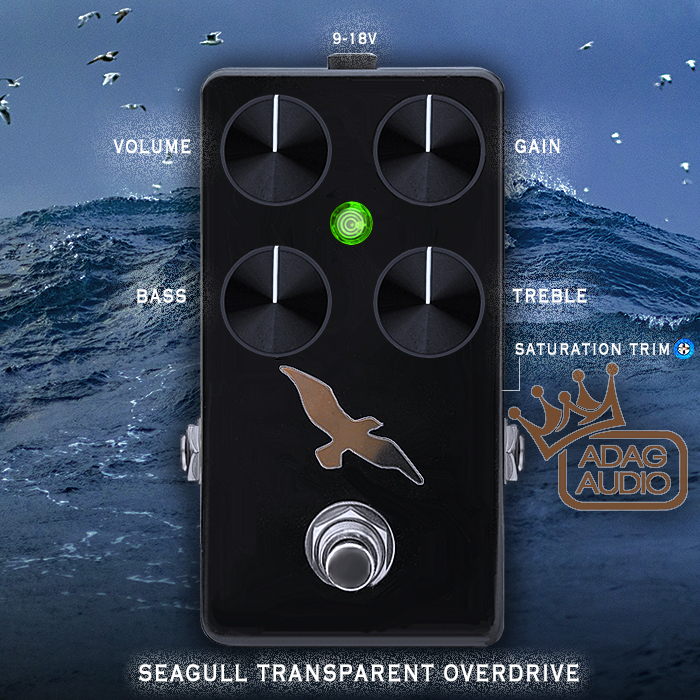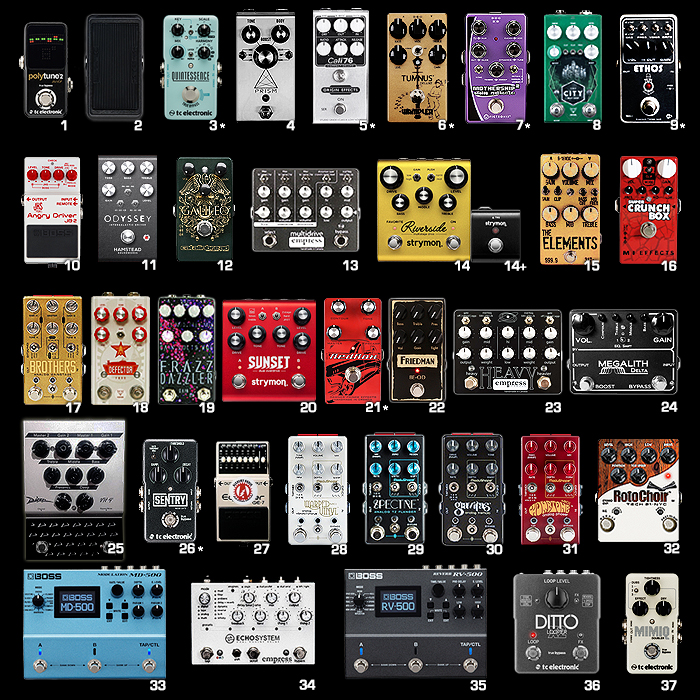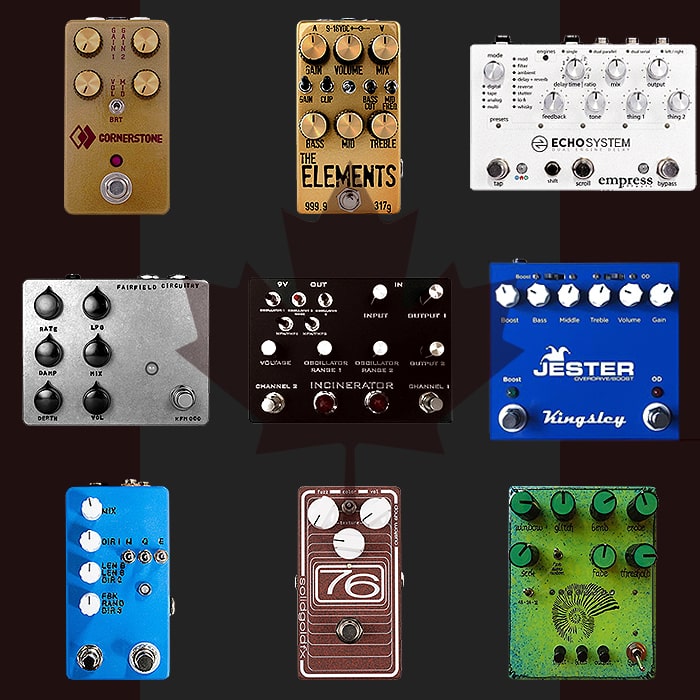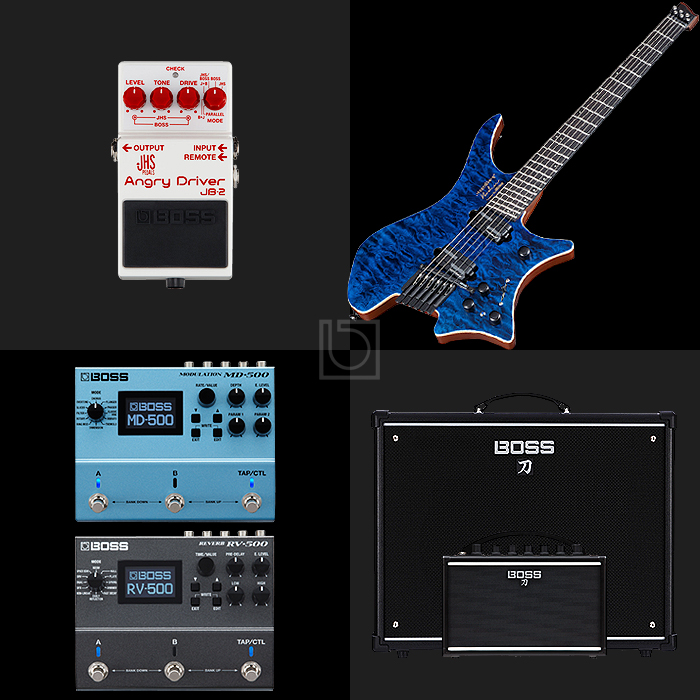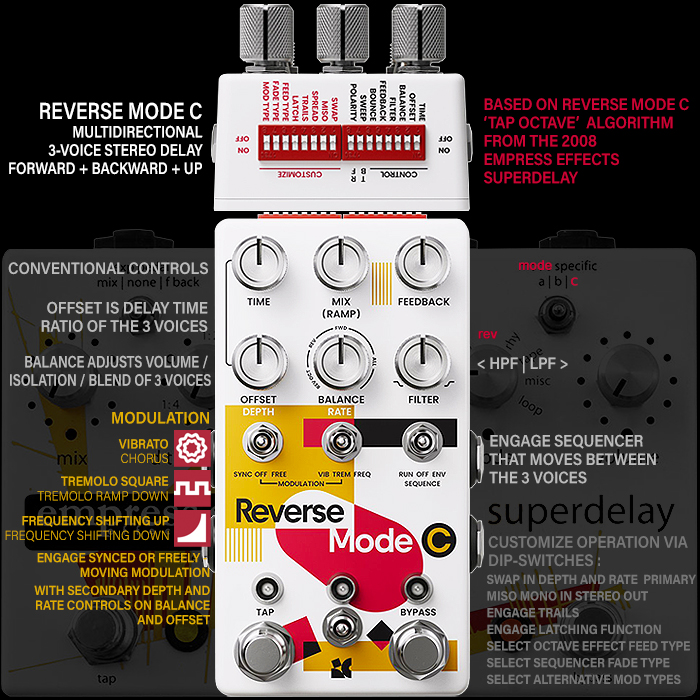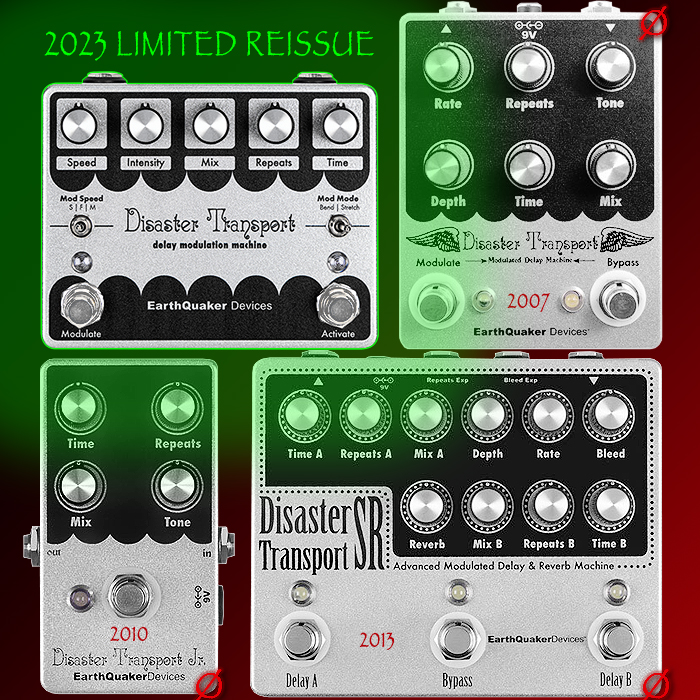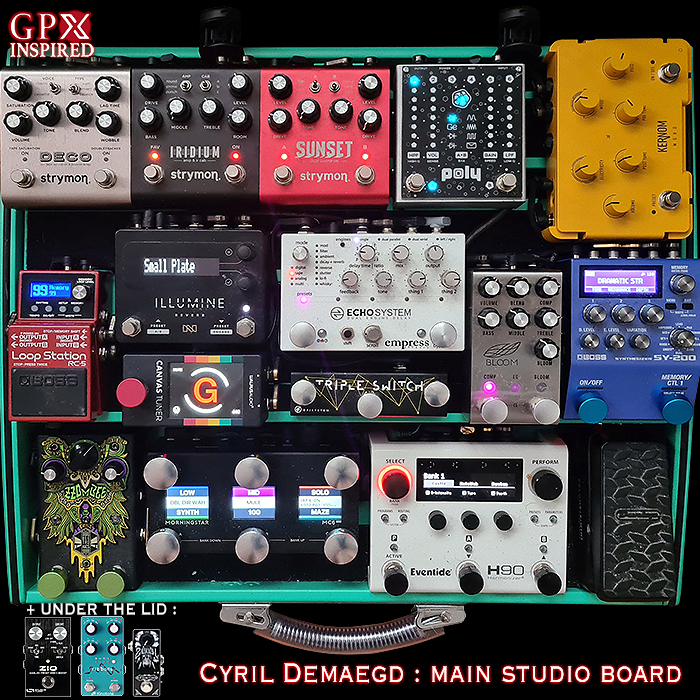Empress EchoSystem vs Strymon TimeLine

Up until this point I was a fully avowed and singularly dedicated Strymon follower, being a huge fan of their flagship pedals which I use daily - The Mobius, TimeLine and BigSky. In fact I had been aware of Empress for a while - for their ParaEq, Multidrive and Heavy pedals in particular. Although it wasn’t really until the Empress Reverb that my interest was fully piqued. Both the Empress Reverb and Strymon BigSky are amazing Reverb workstations and each has its pros and cons - while there is much to recommend either choice. On balance though I concluded that for my current needs etc. the BigSky was largely preferable for now. This does not mean I have discounted the Empress Reverb entirely, as it is still high on my wishlist - I am hoping that Empress does a Dual Engine version of that too so I don’t need to concern myself overly with the forthcoming Source Audio Dual Engine Ventris Reverb.
For the Empress EchoSystem it’s already a totally different ballgame - not only does it house a phenomenal 36 different delay effects algorithms, it allows you to deploy them singularly or in dual-stack combinations - in series / parallel / or left/right stereo split. What this new pedal empowers you to do with your guitar is just second to none - it is easily the most capable and versatile delay pedal currently available. And however good the TimeLine is - and it is plenty amazing in its own right, it is now somewhat overshadowed by the powerful virtuosity of the EchoSystem.
I have tried to compare the two pedals head-to-head as fairly as possible- outlining both their inherent strengths and weaknesses. It must be said that I am by no means getting rid of the TimeLine - I still love it, and there are some things it still does better than anything else, it’s just that the EchoSystem has taken over as my day-to-day delay pedal of choice.
Both pedals are similar in price (£439 | £427), in fact I added the Strymon Looper Multiswitch (£82) to my TimeLine which brings its price up somewhat. Considering what both these pedals offer, the quality of build, technology onboard etc. these are relatively fair prices for high-grade studio-quality hardware.
For Studio Technicians, the TimeLine is probably more closely matched to those needs - as all the settings can be finely calibrated via sub-menus - to whole integers, and midi etc. is fully onboard, while with the EchoSystem - control is fully analogue as such (dials), and you need an additional external midi box.
Empress EchoSystem - Summary
A significantly smaller footprint than the TimeLine with a more hands-on user experience - all the settings are right there on the surface - via dials and switches. It’s easier to dial in specific effects directly, although not necessarily quicker to get started as you don’t have the already available 100 presets of the TimeLine. Also it’s not as easy to dial in the same settings the second time - as you don’t have exact integers on display (no screen) to cross-reference with.
These two pedals are actually technically quite different approaches, as the TimeLine has 12 full-scale engines with lots of scope for sub-menu settings and refinements - different waveforms etc. while the EchoSystem effectively separates out specific sounding effects - as an example - for Tape/dTape delay - the TimeLine gives you a variety of settings to modulate age, crinkle, wow & flutter, - while the EchoSystem has separate New Tape and Old Tape engines etc. - with just a couple of parameter settings via the Thing 1 & Thing 2 dials.
Overall I sort of prefer the EchoSystem approach, but it is tricky to keep having to go back to the handbook to recall what function Thing 1 and Thing 2 are serving. Even though I love the overall functionality and the aesthetic of this pedal, I still think it would / could benefit from a screen display - and I’m not talking about sub-menu selections, but simply to highlight what presets are active, and what parameters are assignable on Thing 1 & Thing 2. When you are stood up it’s not always easy to grasp what is selected - as the writing is relatively small.
I still have a few operational issues to get over while I am ongoingly learning about and living with the pedal - i.e. like how to switch back to manual panel mode once you are done with using presets? Otherwise my experience thus far has been enormously favourable. There are just a couple of things worth mentioning which the TimeLine handles better.
Firstly the volume on the EchoSystem seems to jump fairly significantly between Engines, and particularly when switching to dual modes - which require a little more tweaking of the Mix and Output Dials than I would like - the Strymon seems to equalise the effects much better for smoother sequencing between effects.
Lastly, the TimeLine also really benefits from assignable High Pass filter which cuts the low-end warble - meaning that effects are applied in a slightly more balanced fashion versus the EchoSystem which can suffer from distortion artefacts - particularly when ramping up through gain stages - seems that the TimeLine has a smoother curve.
The ideal solution is probably to make use of the best elements from each of the pedals - hopefully Empress can incorporate some of those improvements into firmware updates or at least the next version of this amazing pedal.
NOTE - one minor annoyance for me is that there are 36 mode types, but only 35 presets available, and unlike the TimeLine those presets aren’t fully populated. Would have been good to have all effect types populated to preset - so you can easily flip between and tweak to your preferences, as is the case on the TimeLine. We know that there are more modes en-route, so I’m not sure 35 presets will necessarily and wholly be enough?
EchoSystem - Control Dials & Switches
Elegance itself in arrangement and use, although not always instantly clear what is going on - 13 dials and switches:
- mode - digital | tape | analog | multi | mod | filter | ambient | delay + reverb | reverse | stutter | lo-fi | whisky
- engines - single | dual parallel | dual serial | left / right
- delay time | ratio
- mix (wet/dry)
- output (level)
- feedback (decay)
- tone
- thing 1
- thing 2
- tap
- shift (+engines = order | +mode = solo active engine | +knob/s = assign to expression pedal | +tap = global/delay time source | +scroll = save preset)
- scroll
- bypass
Pros
- More logical arrangement and order of effects
- Largest Number of Delay Effect Engines in one device = 36 (with more to come)
- Dual Mode - Parallel, Serial, Left/Right Stereo
- Having all Settings visible and on the surface
- Speed of Applying Settings
- Simplicity
- Versatility of Thing 1 & Thing 2 dials
- Multi, 5-tap Engine is a thing of genius
- Smart 7-way LED colour-coding - Blue | Green | Red | Yellow | Cyan | Pink | White
- Easy update path via SD card slot and having spare LED colour slots on existing engines - means you could have 7 separate effects per engine - for a grand total of 84 possible
Cons
- No Screen
- Imprecise Calibration vs digits
- More tricky to repeat same settings
- Preset system a little less user-friendly than TimeLine
- Only 35 presets available (7 x 5 coloured LEDS), which is one less than number of effects possible!
- Having to remember all the different properties of Thing 1 & Thing 2 dials
- No onboard Midi (although still Midi-compatible)
- Lack of High Pass Filter option - means you can suffer from occasional low-end warble / rumble / distortion
- Currently missing Looper (although said functionality is confirmed as due soon)
Strymon TimeLine - Summary
Certain things about the TimeLine are still genius - having 100 presets immediately available for quick and easy switching - means you can scroll through 100 presets in seconds, find something you like and then tweak as necessary - I've not felt the need to create my own presets from scratch - have just tweaked existing ones. I know all my favourite presets by name and bank location and can reach them very quickly.
One of the best things about using Strymon pedals is that they use very clever 'Sweet Spot' DSP algorithms to equalise volume and optimise sound quality across all the different engines / effects - which means you don't get a noticeable jump in volume or occasionally slightly harsh overtones which can happen on the EchoSystem - particularly when ramping between gain stages. I find that I need to tweak each individual effect less on the TimeLine - when moving from clean to overdrive to distortion, while on the EchoSystem I seem to need to tweak more often.
Much of the functionality of the TimeLine is slightly buried in sub-menus - meaning that overall the operation of the EchoSystem is simpler. Although probably in a live situation the TimeLine has a slight advantage - it is immediately obvious where you're at because of the screen display, while you end up bending / kneeling down a lot more with the EchoSystem.
As I said previously the perfect delay pedal would probably incorporates elements of both. For my uses I do feel that some of the settings of the TimeLine are a little over-complex and fiddly - I much prefer the simplified approach of the EchoSystem, but would quite like a screen for better visibility / calibration / repeatability. And although the EchoSystems's multi-colour LED approach is genius of itself, it is significantly clearer to have labels on a screen per the Strymon. The TimeLine also has the amazing 'Ice' effect - which is the one and only effect that I am missing so far on the EchoSystem
TimeLine - Control Dials & Switches
Too many options hidden in sub-menus, although it benefits from a big bright screen which instantly allows you to know where you're at - 12 dials and switches:
- Type (mode) - dTape | dBucket | Digital | Dual | Pattern | Reverse | Ice | Duck | Swell | Trem | Filter | Lo-Fi
- Value (settings)
- Time
- Repeats (decay)
- Mix (wet/dry)
- Filter (shape of repeats / cutoff / frequency)
- Grit (distortion artefacts)
- Speed (of modulation)
- Depth (of Modulation)
- A / Bypass / Record (looper)
- B / Bypass / Play (looper)
- C/ Tap / Stop (looper)
Additional Sub-Menu Settings:
- Tap Division (Quarter notes (default), Dotted Eighth notes, Eighth notes, Triplets, Sixteenth notes )
- Boost (+/- 3dB)
- Persist (Trails)
- Name (Preset Name - 16 Chars.)
- Expression Pedal - On/Off
- Express Pedal Set (Config.)
- Tap Mode
- Dry Signal (Normal / Kill)
- Spillover (Preset Transition)
Pros
- Depth of Settings
- Refined Calibration
- Easy repeatability
- Distortion Control / High Pass Filter
- Smart presets system with 100 pre-loaded options and 200 possible slots
- Great sounding 'Ice' engine
- Looper
- Cleverly Equalised volume and sound across effects
- Ability to dial in precise bpm tempo
Cons
- Inherent Complexity / significant learning curve
- Option Paralysis / Too many settings
- Takes longer to dial in particular sounds
- Limited Dual Engine mode vs EchoSystem
- Not as many effects as EchoSystem
- More complex update path / less scope for addition of effects
Delay Engines / Modes / Effects
While there are sort of 8 engines which are largely directly comparable head-to-head, some of the remaining four are kind of out there on their own.
Both pedals have fairly closely matching solutions for Digital, Tape, Analogue, Reverse, Filter, Lo-Fi, Ambient / Swell and Mod / Trem - with the obvious proviso that EchoSystem engines are distinct effects really while TimeLine engines are broader - with more tweakability typically.
I've tried to match the remaining 4 categories as closely as possibly - in that there is some overlap between Stutter and Pattern, but Pattern is much more powerful and includes 16 distinct pattern effects - including 'Ping-Pong' which EchoSystem has under Digital. Next I matched Multi with Dual - although they are too sort of disparate - the former overlapping in some way with the Strymon Pattern - but tap-definable, while Dual gives you a slight flavour of EchoSystems's dual engine capability, but only with the Digital delay effect. Next are a couple of oddities - EchoSystems's Delay + Reverb (Plate/Hall) and TimeLine's 'Duck' - where EchoSystem handles ducking effects within Digital mode.
Finally we have two quite distinct categories, possibly the most unique and celebrated TimeLine engine - 'Ice'. While the EchoSystem provides two almost equally loved but highly quirky - Knob's Seesaw and Christopher Glitchens modes.
Also remember that both pedals have 7 similar tweakable dials, albeit that EchoSystem Thing 1 & Thing 2 functions change more often than equivalent TimeLine values:
ES = delay time + ratio | mix | output | feedback | tone | thing 1 | thing 2
TL = time | repeats | mix | filter | grit | mod speed | mod depth
NOTE - you will frequently see the following notation - (20Hz to 900Hz ÷20) - this denotes several frequency values ranging from 20Hz all the way up to 900Hz in 20 individual option steps.
Digital - EchoSystem
- Pristine
- Short Stuff
- Ping Pong
- Dynamic Duck
- Dynamic Feedback
- Thing 1 - Mod Depth / Duck Amount
- Thing 2 - Mod or Release Speed / Bandwidth / Duck Threshold
Digital - TimeLine
- Smear (%)
- High Pass (20Hz to 900Hz ÷20)
- Repeat Dynamics (taper speed - on/off)
Tape - EchoSystem
- New Tape
- Old Tape
- Echoplex
- Space Echo
- Thing 1 - Mod Depth / Saturation / Drive
- Thing 2 - Mod Speed / Mod Depth+Speed
dTape - TimeLine
- Tape Speed (fast/normal)
- Low End Contour (%)
- Filter - Tape Age
- Grit - Tape Bias
- Speed - Tape Crinkle
- Depth - Wow & Flutter
Analog - EchoSystem
- BBD (Bucket Brigade Devices)
- Tube BBD
- Deluxe Memory Boy
- Thing 1 - Saturation / Vibrato
- Thing 2 - Modulation / Chorus
dBucket - TimeLine
- Range (single/double)
- Filter - darker/brighter
- Grit - Bucket Loss degree
Reverse - EchoSystem
- Reverse Delay
- Reverse Dual Pitch
- Triggered Reverse
- Thing 1 - Hi Freq. / Pitch 1 / Swell Time
- Thing 2 - Compression / Pitch 2 / Chorus
Reverse - TimeLine
- Smear (%)
- High Pass (20Hz to 900Hz ÷20)
Filter - EchoSystem
- Pulse Filter
- Warp Filter
- Swoosh Echo
- Thing 1 - Pulse Freq. / Sensitivity / Modulation
- Thing 2 - Pulse Speed / Response Speed / Swoosh Speed
Filter - TimeLine
- LFO - +/- Triangle / Square / Sine | Ramp / Saw / Random / Down / Up (÷11)
- Speed (1/32 to 32/1 ÷34)
- Depth (%)
- Filter Q (0.5 to 10.0 ÷12)
- Location (pre/post)
- High Pass (20Hz to 900Hz ÷20)
Lo-Fi - EchoSystem
- Old Timer
- Digital Death
- Thing 1 - Oldness / Alias Freq.
- Thing 2 - % Break-up / Alias Blend
Lo-Fi - TimeLine
- Sample Rate (750Hz to 96kHz% ÷21)
- Bit Depth (4 to 32 ÷21)
- Mix (% Dry vs Corrupted)
- Vinyl - Dynamic / Static (%)
- Filter Shape - Off / Portable Vintage Amp / Victoria Phonograph / 70's Clock Radio / Bullhorn Megaphone / Cheerleader's Megaphone / Antique Telephone Ear Piece / Cell Phone / Apartment Intercom
Ambient - EchoSystem
- Drunk Ewok
- Triggered Swell
- Triggered Multi-Swell
- Long delay
- Thing 1 - Delay Pattern / Swell Time / Modulation Depth
- Thing 2 - Diffusion / Modulation / Flanger % / Modulation Speed
Swell - TimeLine
- Rise Time (0.10 to 4.00 ÷28)
- Smear (%)
- High Pass (20Hz to 900Hz ÷20)
Mod - EchoSystem
- Panning Delay
- Tremolo Delay
- Waveform
- Thing 1 - Pan Width / Tremolo Depth / Waverform
- Thing 2 - Pan Speed / Tremolo Speed / Modulation
Trem - TimeLine
- LFO - Triangle / Square / Sine / Ramp / Saw
- Speed (1/32 to 32/1 ÷34)
- Depth (%)
- High Pass (20Hz to 900Hz ÷20)
Stutter - EchoSystem
- Chop Mode
- Auto-Stutter
- Thing 1 - Chop Speed / Filter Sequence
- Thing 2 - Modulation / Filter Aggressiveness
Pattern - TimeLine
- Pattern (1 to 16 separate patterns) [Various pre-defined patterns, including Ping Pong and several unique rhythms / stutters etc.]
- Smear (%)
- High Pass (20Hz to 900Hz ÷20)
Multi - EchoSystem
- Digital Multi-Tap
- Tone Taps
- Preset Patterns
- Thing 1 - Intensities per dial dot / Variations per dot / Pattern per dot
- Thing 2 - Depth & Width / Volume & Pan Variations
Dual - TimeLine
- Time 2 - (1/8 to 8/1 ÷27)
- Repeats 2 - Track (%)
- Mix 2 - Track (%)
- High Pass (20Hz to 900Hz ÷20)
- Configuration - Series / Parallel
NOTE - Time 1 is set using physical dials
Delay + Reverb - EchoSystem
- Hall
- Plate
- Thing 1 - Delay + Reverb Mix
- Thing 2 - Reverb Decay
Duck - TimeLine
- Sensitivity (%)
- Release Time (0.01 to 1.00 ÷21)
- Ducking Feedback - Normal / Gate
- High Pass (20Hz to 900Hz ÷20)
Whisky - EchoSystem
- Knob's Seesaw
- Christopher Glitchens
- Thing 1 - Quiet Pitch / Pitch 1
- Thing 2 - Loud Pitch / Pitch 2
Ice - TimeLine
- Interval - Octave / -Major 7th / -minor 7th / -Major 6th / -minor 6th / -Perfect 5th / -Tritone / -Perfect 4th / -Major 3rd / -minor 3rd / -Major 2nd / -minor 2nd / -50 cents / -25 cents / +25 cents / +50 cents / +minor 2nd / +Major 2nd / +minor 3rd / +Major 3rd / +Perfect 4th / +Tritone / +Perfect 5th / +minor 6th / +Major 6th / +minor 7th / +Major 7th / +Octave / +Octave & 5th / +2 Octaves
- Slice - Short / Medium / Long
- Blend - Dry to Ice
- Smear (%)
- High Pass (20Hz to 900Hz ÷20)









